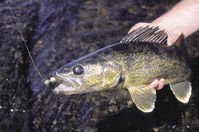
There is a time in summer when daylight lingers long into the evening, as if the sun is reluctant to set. It’s a great time to be on the water, fishing for just about anything, but especially for walleyes. The fish have recovered from the spring spawn and are actively feeding on a wealth of aquatic life, from bait fish to insects. In other words, the walleyes are biting.
This is a time when you can catch walleyes throughout the day on many northern lakes, especially those with dark water. But even when they are hungry, walleyes bite best during low light periods—morning, evening, or overcast days. Generally, those are the best times to go fishing for them.
I enjoy evening walleye fishing, because feeding fish move into shallow shoreline and shoal areas where they are easy to locate and catch. When fishing familiar waters with my canoe, I don’t even use an electronic fish-finder to look for them. Instead, I rely on experience—trying places where I’ve caught walleyes in the past—or visually seeking spots to make a few casts.
What do I look for? Shorelines structure such as points or shallow bars are easy to recognize and attractive to walleyes. I also like shorelines with newly emerged aquatic vegetation. Walleyes often feed along the outside edge of vegetation, even though the water may only be a foot deep. Shoreline shelves adjacent to deeper water are good places to try as well.
My strategy is to get on the water just after suppertime, which gives you about three hours of fishing. I might begin by trolling with a spinner and crawler or leech to see if I can find active fish and determine the depth where they are holding. If trolling is productive, I may stick with it, though I prefer to cast with jigs.
I use flourescent-painted 1/8- and ¼-ounce jigs tipped with bait for the bulk of my midsummer walleye fishing. They are inexpensive and easy to use. For bait, I start with minnows and then switch to leeches and crawlers around mid-June, because they keep better and are more productive than minnows during the summer.
The fishing technique is easy, too. Cast out and let the jig settle to the bottom, then slowly hop or drag it on the retrieve. Expect soft pick-ups from walleyes, perhaps a tap-tap you feel through the rod or just a sensation of extra weight on the line. Pause for a moment to allow the fish to take the bait. When you feel the fish on the end of the line, set the hook.
Another way to catch walleyes and avoid hanging up on the bottom is to use a slip bobber. Set the depth of the bobber so your jig is near the bottom. This is a great way to catch actively feeding fish. You can also use a slip bobber to fish in very shallow water. I prefer to use a bobber in situations where I know the walleyes are biting and cast a jig when prospecting for hungry fish.
Walleyes often follow an evening feeding pattern. The first fish you catch will be in somewhat deeper water, perhaps 10-15 feet. As the evening progresses, they’ll move to shallower depths. Pay attention to where you find the biters and you will notice this movement to the shallows is occurring. I usually start the evening by casting toward the open lake and finish off by casting toward shore.
Numerous lakes throughout the Northern Wilds contain abundant walleye populations, so finding a place to fish isn’t difficult. I prefer small to medium-sized lakes; others like big water. The size really doesn’t matter. What does matter is that you get out there now and enjoy good walleye fishing.


